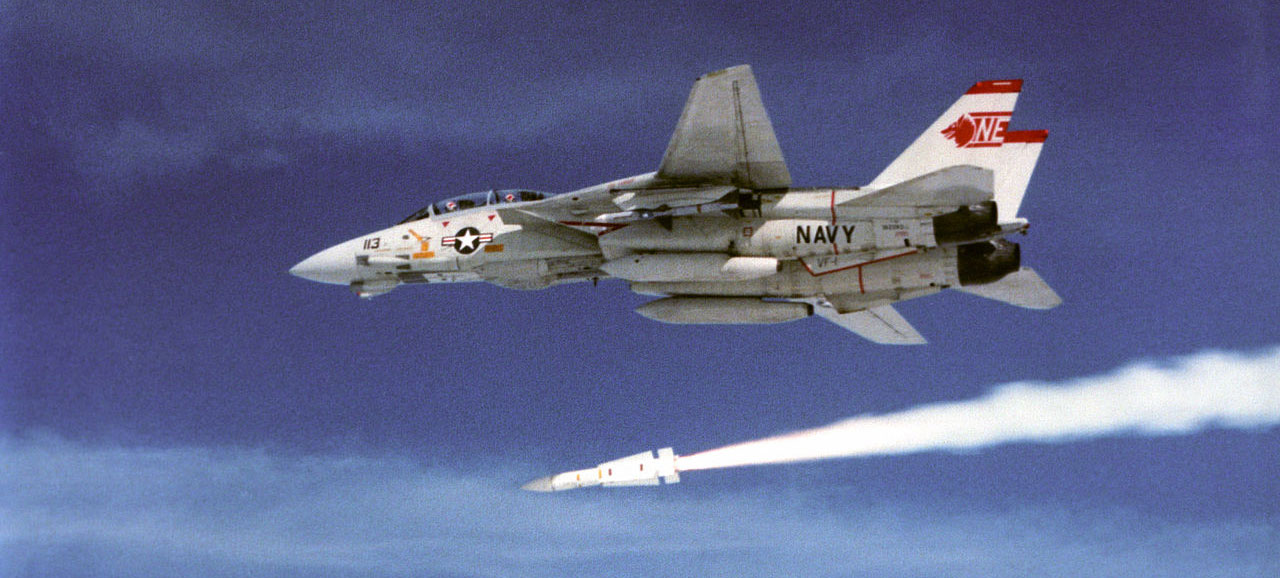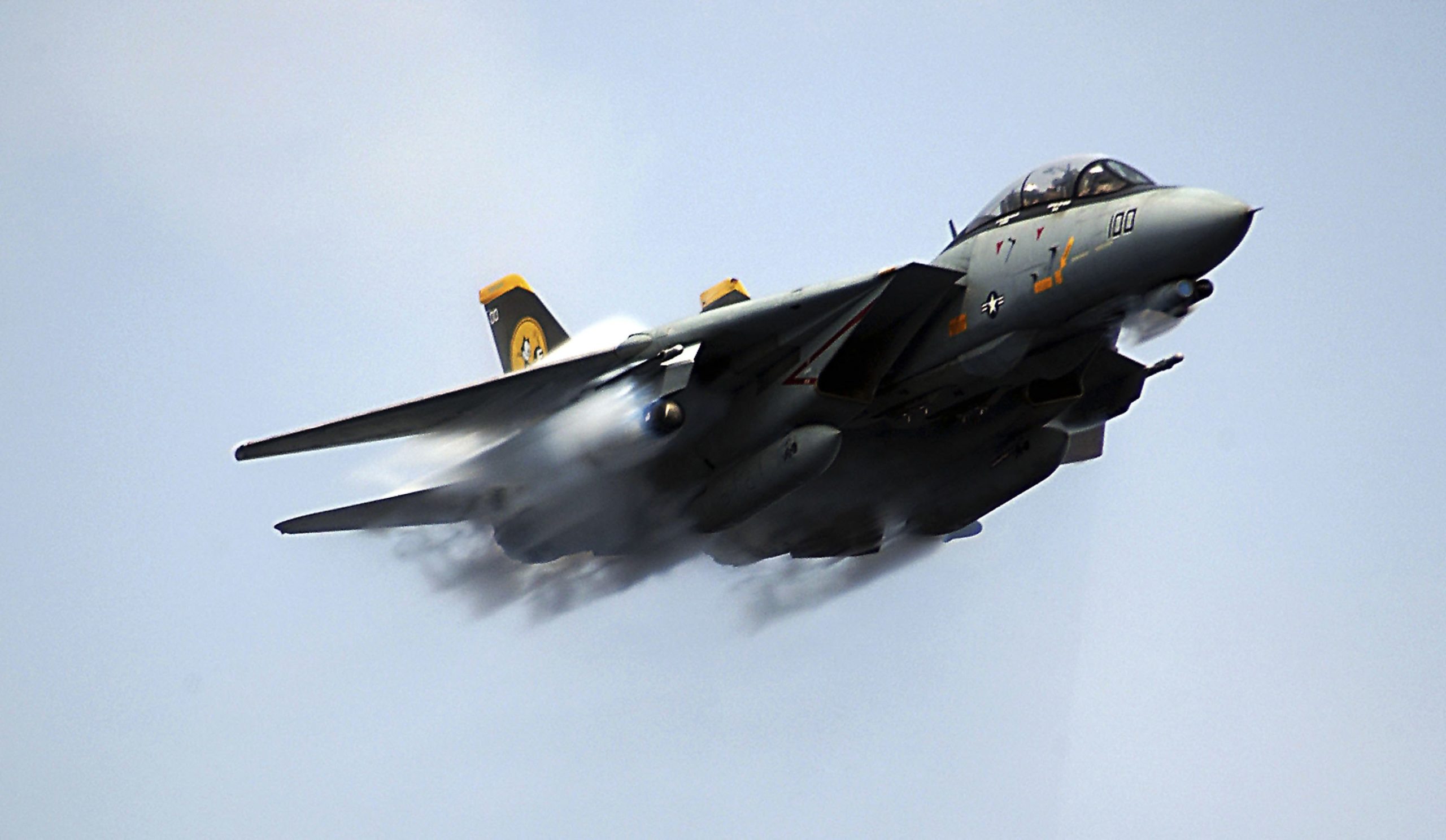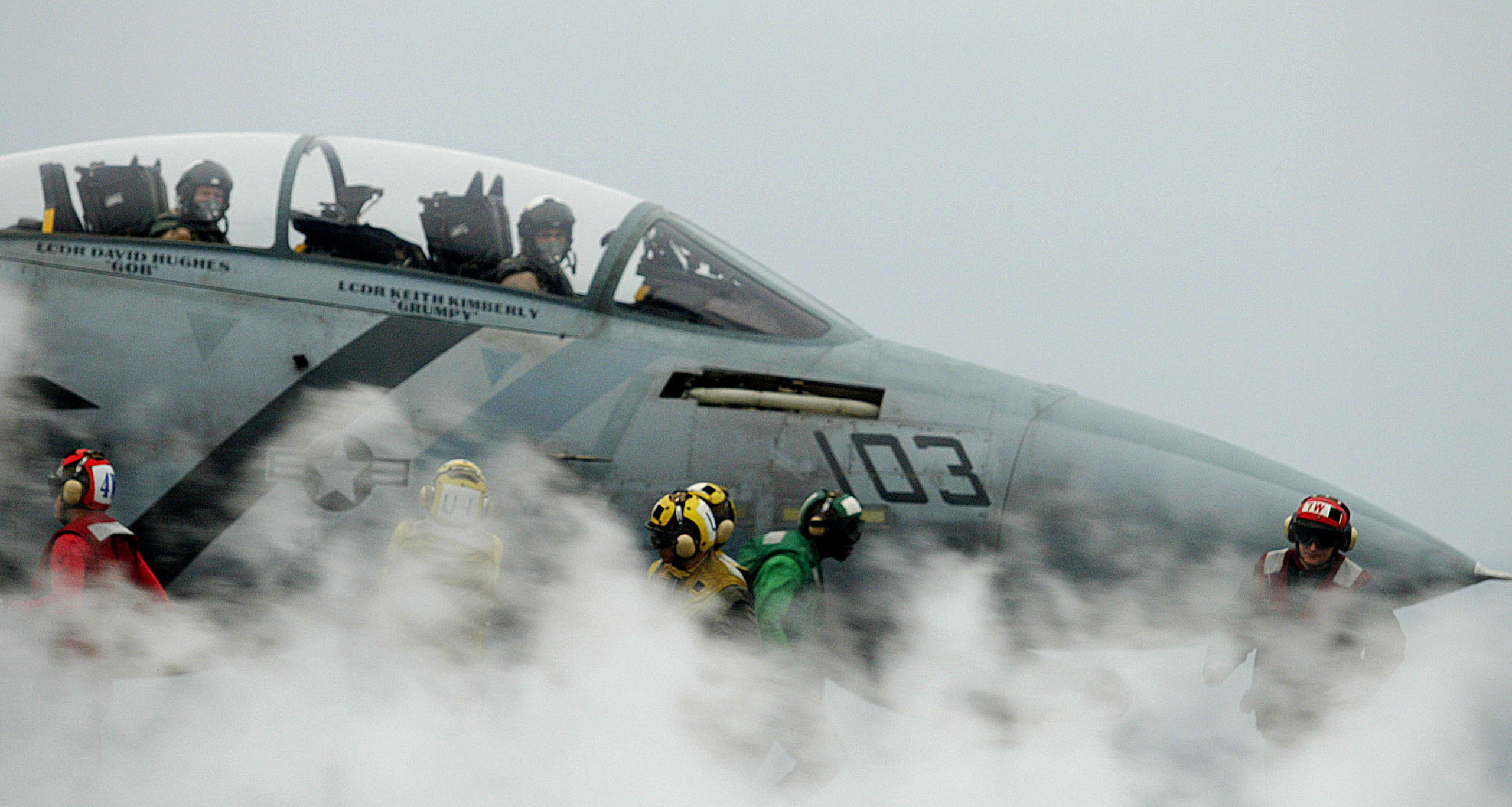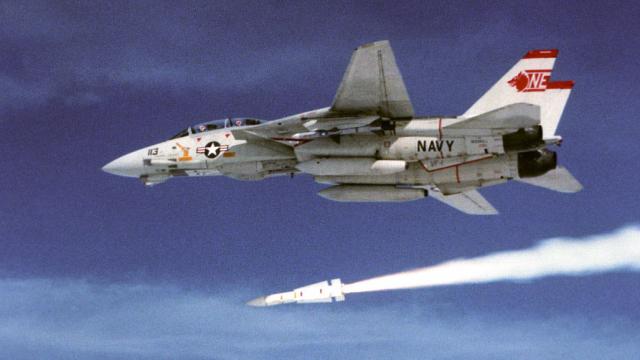The F-14 Tomcat was a Cold War fighter first deployed in the 1970s. For over 30 years it served the US Navy with distinction, yet its greatest legacy is perhaps found not on the battlefield, but in the hearts of kids like me who grew up with certain cartoons, movies and video games.
There’s a weird point where military hardware and popular culture can sometimes intersect. On the one hand, in intent, tanks and jets and guns are supposed to kill and/or protect. Sometimes though, a vehicle or weapon can strike a nerve and move beyond their original design to become something else. Something suggestive, something poetic, something entirely outside the realm of military matters altogether. Take the AK-47: It was originally a firearm for Soviet infantry, but thanks to film and music (rap especially) it’s now as much a symbol of resistance and crime as it is the Red Army.
For a generation of kids who grew up in the ’80s, this also applies to the F-14 Tomcat.

An F-14A firing an AIM-54 Phoenix missile in 1991.
Developed by Grumman to protect aircraft carriers from Soviet bombers, and entering service with the US in 1974, the Tomcat was both a fighter and interceptor. It was huge, easily the biggest American fighter to ever be based on a carrier, with its large size necessary to accommodate its two trademarks: A big radar in the nose and the big AIM-54 Phoenix, America’s only long-range air-to-air missile (the Tomcat was the only fighter to ever carry the missile). It remained in service until 2006.
I was one of the kids who grew up idolising this aircraft, and I had (and I guess still have) a bizarre affinity for the jet. I’m going to guess that, alongside some unique qualities I’ll get to in a bit, it has something to do with its starring role in three pivotal pieces of popular entertainment.
MACROSS (1982)
Perhaps known better in the West by its collected series name, this opening act of the Robotech saga has a cast full of weird and wonderful creatures, both human and otherwise, but they’re all outshone (and outloved) by the series’ transforming Veritech Fighter.
Heavily based on the design of the F-14, Macross’ designers clearly fashioned the VF-1 as a homage to Grumman’s fighter, taking not just all the jet’s visual trademarks — including its double engines and swept wings — but even actual squadron insignia, with Macross’ Skull Squadron lifting the colours and insignia of the US Navy’s VFA-103.

I was obsessed with Macross/Robotech growing up, and it remains one of my favourite anime series to this day. So I also grew up with a lot of merch associated with it, which meant having a lot of little transforming F-14s lying around the house.
TOP GUN (1986)
It’s crazy realising that Macross was made so many years before Top Gun, because the intros to both — fetishising the act of launching off a carrier deck — are so similar. But where Macross made only superficial reference to the Tomcat, Top Gun put the jet centre stage, inviting audiences to learn everything about it, from its capabilities to its strengths to its… well, just its strengths, actually, since the film was literally US military propaganda.
The effect this movie had in turning the F-14 from a piece of military equipment into a movie star can never be understated.
AFTER BURNER (1987)
One of the definitive Sega video game experiences, After Burner‘s frantic action — coupled with its famous booth, which you can see below — helped cement its place as one of the most iconic arcade games of the 1980s. Its use of the Tomcat as the player’s aircraft meant the F-14 was the focal point of the entire game, and ensured it was visible in every arcade and game store on the planet.
By 1987, then, the Tomcat wasn’t just another US military jet. It was a star in its own right, an actor appearing across properties, bouncing from Top Gun to After Burner like Tom Cruise going from Top Gun to Rain Man. A generation’s repeated exposure to the same piece of hardware in things that were cool and fun had the effect of marking it as some kind of aerial superhero.
This attachment had nothing to do with foreign policy or knowledge of aeronautical engineering. It was probably just that a lot kids of the ’80s had an obsession with badarse machines, and there were few more badarse than an enormous fighter jet with skulls on it that could move its wings, carry giant missiles, and was in Top Gun.

Beyond its role in those series it helps that the F-14 had other things going for it that might explain its popularity with a generation of young dorks like me. For one, its unique design, a subtle melding of curvaceous lines across its nose and wings with the brutal functionality of those giant engines, meant it looked absolutely killer. There was also something cool about the fact it took two to operate it, as though it were a beast that a lone pilot simply couldn’t tame.
It was also very American in a time when, as someone who is not American, that was a cool thing to be. In the 1980s, as a kid living in Australia, the USA was not a complicated land of wage inequality and social strife. They were just the good guys in a global war against the bad guys.
And thanks to stuff like Top Gun, the F-14 was seen as an American icon, a symbol of the nation’s strength and ability to project it around the world. If Hulk Hogan was the Real American Hero of the 1980s on land, then the Tomcat — which aside from a small shipment to Iran was, unlike most American fighters, never sold to its allies in Europe and Asia — was filling the same role in the skies.

Image: Yo Joe
This all came together to make the F-14 a rock star. I had posters of the fighter on my wall alongside football players and Ninja Turtles. I had a T-shirt with this amazing iron-on graphic of a Tomcat in flight. I maybe had four or five different model kits of the fighter. Even GI Joe cashed in, basing the flagship Skystriker playset — something I always asked for but never got for Christmas — on the Tomcat.

I loved this thing like a favourite character in a comic series. Isn’t that nuts? It was a fighter jet, a hunk of metal and weaponry, but because of a perfect storm of factors present in my childhood (Cold War, Top Gun and so on), where a lot of other boys grew up going crazy for Ferraris, I spent the early years of my life obsessing over a carrier-based interceptor. And I know I was far from the only one.
And so I miss the F-14. An enormous killing machine, built by the military industrial complex to blast Soviet missiles, but which for a load of kids was something entirely different. A symbol of a simpler and more boisterous America, of a machine that was adored aside from its intent, and if nothing else should always be thanked and remembered for this:

Comments
10 responses to “A Love Letter To The F-14 Tomcat”
On the Macross thing, Kawamori is a massive fan of the F-14 and the VF-1 is absolutely based off it. He’s talked about it in interviews and stuff.
There’s just something about the design that is just rad. There is no angle that the aircraft doesn’t look awesome.
It IS looking a little 80s now… but yep. Beautiful design.
I’m sure I flew this amazing piece of military hardware in a a bunch of old Flight Sims that tried to recreate the experience of getting behind the controls of one of these things.
Those old military sims were epic, I flew an AH64 Apache Gunship, drove around in an M1 Abrahms tank, and the attention to detail was ridiculous, usually the manual was a full 100 pages plus. Not sure how they got away with it at the time, can’t imaging the US military letting that sort of a game go to publication today.
Ahhhhh the 80’s a much more innocent time and place.
Great story – spot on in basically every way.
The F-15 has some beautiful lines, but is a bit boxy, and the F-16 is a wicked looking thing but is a bit small – the F-14 gets the best parts of both.
This is still the premier quality of Aeronautical engineering probably only outdone by the F-22.
This plane had it’s faults in the early days with a weaker engine, but once those were replaced with the GE F110-400’s it was a beast. Economically it probably makes more sense for the USN to replace it with the F-18 A/B/E series, but I still think the F-14 would have dominated when it came to air-superiority missions.
Also featuring F-14’s:
– Macross Zero (First episode was dope…)
– Final Countdown
– Executive Decision
f-22 has shit turn rate due to draggy “stealth” airframe. Poor climb and bleeds energy in turns like a menstrating prostitute on prom night without a tampon. The f-14D has an IRST (infrared) and aim-54 phoenixes that can track and kill the f-22 raptor farther than the f-22 raptor can lock onto a tomcat with aim-120 missiles. F-22 is hotter on IRST than normal jets, especialy from the front because of it’s draggy frame and absorbant paint.
It’s cool, but it’s not A10 Thunderbolt Cool
*brrrrts away*
Supermarine Spitfire Mk Ia. Just sayin…
I racked a fair number of hours playing Tomcat on the Atari 2600. Amazing amount of detail for the hardware it was running on.
Add in F-14 Tomcat on C64 where you fly one AND get to to go Top Gun.
Every kid in the 80s that watched Top Gun piloted an F-14 in their wardrobe or bed with various accessories used for the controls and navigation systems.
Basically described my thoughts and feelings on it growing up as well, it was and still is just damn cool. There are only a couple of planes that I feel are as beautiful such as the F-22, the SU-35 with its awesome blended wing and forward canards, and SU-47 with its forward swept wings are just iconic, but none are as iconic and as beautiful as the F-14.
I’m an American born in ’81. My dad sent me this because of my same nostalgic feeling as written. While I was a Marine I wound up meeting a few Tomcst pilots over the years. Roughly 1-3% of the Navy’s pilots were able to meet the standards to fly those awesome fighter. I saw combat numerous times and only played games stated in story. Never play call of duty or anything by my GF and son do hahaha. I found Ace Combat 6 with the F-14 once a week 😉